As a product manager, the Kano model was an a-ha moment for me. It gave a name and a framework to a lot of the conversations around product design and features I’ve had all these years with bosses, clients and startups.
The model helps identify, from a customer perspective, which features are key differentiators, which are a must but won’t bring any value and, more importantly, which are not relevant and are therefore a waste of time and resources.
And this is especially relevant for startups since it helps define a better MVP, speed up time to market, and invest strategically in features that really help the product grow.
But beyond startups, the Kano model is a great tool to drive conversations around product strategy, development and features, and can be used in many different ways throughout the product cycle:
- Product design
- MVP definition
- Define and prioritize features
- Product roadmap
How the Kano model works
The model was developed by Japanese professor Noriaki Kano back in the 80s, who worked in the areas of customer satisfaction and quality management.
It maps customer satisfaction against effort or investment identifying four types of product features:
- Basic: these are the features a product must have if it wants a chance at competing.
- Neutral: features that don´t add value and may not be worth developing.
- Performance: the bigger these features or the more of them you add, the more satisfaction you create.
- Delighters: these are your key competitive advantage make up your Unique Value Proposition.
In addition, the model shows how all of this changes over time, which is important to understand as the product transits is life cycle.
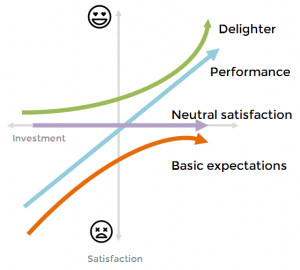
The two axis of the model are:
- Customer satisfaction in the vertical axis, from Delight at the top to dissatisfaction at the bottom
- Cost, sophistication of the feature or quality of execution in the horizontal axis. Since all of them tend to correlate with effort, it can also be defined as investment needed (resources, money). So I’ll just call the horizontal axis “investment”.
I want to emphasize that the key of this model is that evaluates features from a customer perspective. Let’s use the example of a car to dive into the model.
Basic expectations
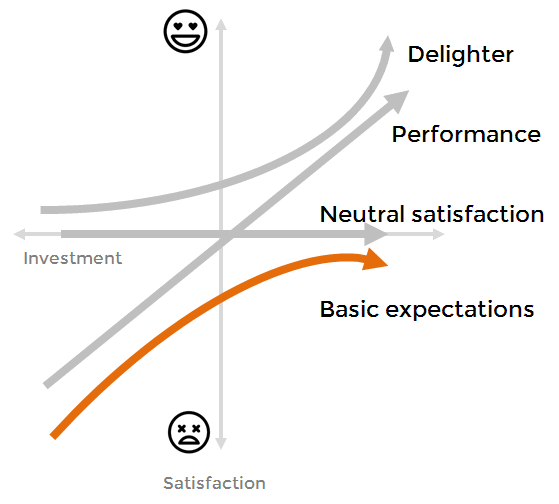
These are must-haves: if you don’t have them your product is either not a viable option for consumers or will be perceived to have inferior quality as it misses basic customer expectations.
These are so basic that customers take them for granted. Therefore they won’t talk about them unless they are absent or are not performing well.
The steering wheel, the brake or headlights are examples of this. No one is going to say that they want a car with brakes, nor will you be praised for your fabulous steering wheel. But if any of these are missing no one will buy your car.
Note that they never cross above the neutral satisfaction line. This is because they are so basic that their presence simply avoids dissatisfaction.
Because you need to invest in those functionalities in order for your product to be a viable player, they are also called “pay to play”.
Key points:
- These features are the basis of a successful product strategy, so make sure you know what the basic expectations about your product are.
- The absence of a basic feature could mean losing customers to your competitor or your product being perceived of a lower quality.
Neutral satisfaction
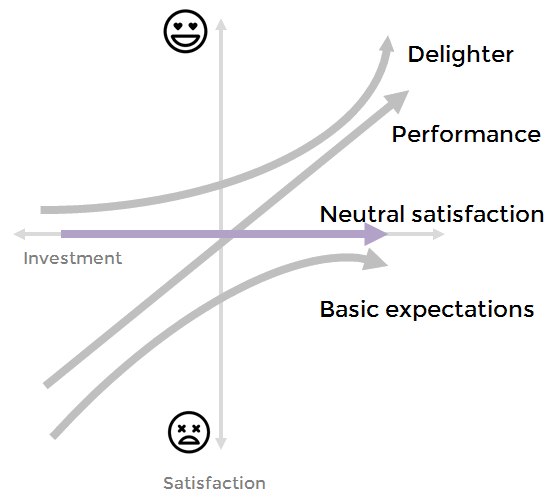
As the name indicates, these features don’t make a difference to your customers so investing in them won’t provide any benefit. It is important to identify them so you don’t waste your budget.
If you work with digital products these features are especially tricky and there are a few things you need to watch out for:
- These are the typical features that your dev or design team will add because they are easy to make and cheap to implement but don’t really mean much to your customers. Because they are so easy to add, they increase the complexity of your product over time, which in turn has an impact on maintenance.
- Sometimes there is a fine line between neutral and performance or excitement. The difference may lie in how well the feature was implemented, or it may be appreciated differently by different customer segments.
Leather sits, tinted windows or other “extras” are examples of this. Because they are appreciated by some customers but not by others, they are usually presented as add ons.
Digital products are usually full of those features, and they tend to make the bulk of the backlog. They are the typical features that you add because you can but that no one even notice or use them. Word and Excel are full of features that 98% of users don’t use or don’t even know exist.
Key points:
- Test these features with different segments to make sure it is worth investing in them.
- Test different ways to implement these features to make sure you’re not discarding a potential excitement generator.
- Make sure the complexity they add is worth it. And at the same time, try to add them in a way that is easy to remove if you ever need to reduce complexity.
- While they may not make a difference to your customers, you may use them for marketing purposes or to create pricing strategies
Performance features
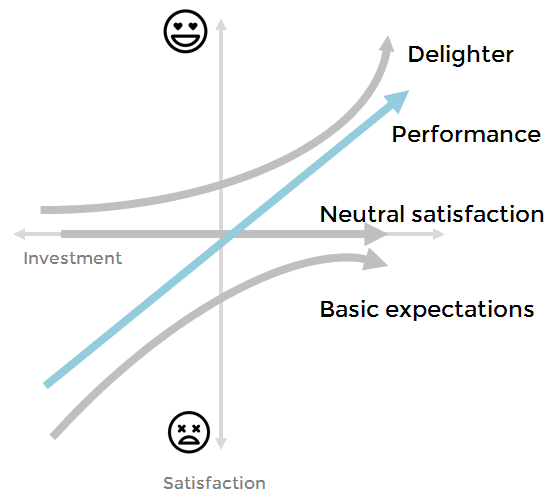
The more you add of these features, or the bigger they are, the more satisfaction you create. Gas mileage, trunk space, miles covered by the manufacturer’s warranty are good examples.
As you add more of these features you may be increasing the cost of your product, but since satisfaction increases in equal amounts, investment in these features makes sense.
Implementation is key: while it is true that the more you have of these the more satisfaction you will generate, if they are not well implemented they will cause dissatisfaction.
Key points:
- These features are product differentiators and should be a priority in your product roadmap.
- However, be sure to validate these features with users before you commit to building them in order to avoid wasting budget and time: how much more are they willing to pay for this attribute? And conversely, what is your ROI?
Delighters
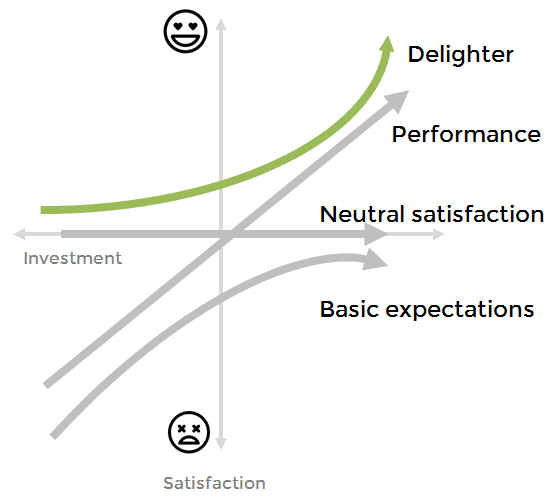
These are the features that make up your unique value proposition and create your competitive advantage. If absent, these features don’t create dissatisfaction, but when present they create a more than proportional amount of value.
Toyota’s Prius is a prime example of this: its dual sources of energy, delivered a much higher mileage than its competitors and had a lower environmental impact.
While innovation is a great source of delighters, sometimes these features can be very inexpensive to build: offering a VIP waiting area or a car loaner while your car is in for service is a great and inexpensive way to delight your customers.
In new product categories any feature can be a delighter since everything is new. But in more established markets delighters can be found more on the product experience than in the product performance.
These features create excitement precisely because they are not expected. And because customers don’t know they want these features until they see them, they will rarely describe them to you. You find them through creativity or intuition after listening to your customers.
Key points:
- Focus on the product experience to find sources of delighters.
- You can turn basic expectations into delighters: for example Southwest airlines re-signified its little to no onboard service into a delighter by way of decreasing its price.
- Or you can bundle up a few features to create one larger excitement source. For instance parking camera + built-in Bluetooth + GPS + keyless entry.
The effect of time
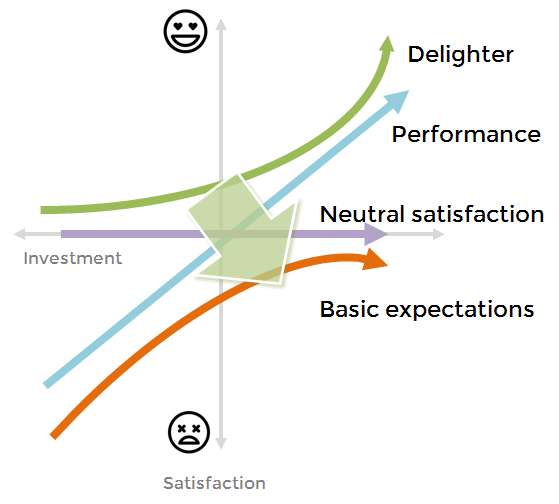
Since customers get used to the new features and competitors catch up, over time delighters become performance features and then part of the basic expectations. This means that user research needs to be ongoing in order to identify erosion of excitements and opportunities for new delighters.
Key points:
- Frustrations can become opportunities for new delighters
Getting started
The first step in using the Kano model is to talk to your customers to map your features against the four categories (basic, neutral, performance or excitement generator) so you can adjust efforts and priorities accordingly.
Remember that the importance of the features decay over time, so it is important to conduct user research regularly. This will not only help you monitor where your features fall over time, but also to discover opportunities for new excitement generators.
… And one more thing
The goal of this article is to introduce the strategic value of the Kano model for product development and provide a framework of reference for evaluating current and future product features so you can optimize your efforts and make sure you’re developing a product that is in-line with customer expectations.
If you want to dig deeper into how to measure customer satisfaction, these articles provide in-depth details:
As a product manager, the Kano model was an a-ha moment for me. It gave a name and a framework to a lot of the conversations around product design and features I’ve had all these years with bosses, clients and startups.
The model helps identify, from a customer perspective, which features are key differentiators, which are a must but won’t bring any value and, more importantly, which are not relevant and are therefore a waste of time and resources.
And this is especially relevant for startups since it helps define a better MVP, speed up time to market, and invest strategically in features that really help the product grow.
But beyond startups, the Kano model is a great tool to drive conversations around product strategy, development and features, and can be used in many different ways throughout the product cycle:
- Product design
- MVP definition
- Define and prioritize features
- Product roadmap
How the Kano model works
The model was developed by Japanese professor Noriaki Kano back in the 80s, who worked in the areas of customer satisfaction and quality management.
It maps customer satisfaction against effort or investment identifying four types of product features:
- Basic: these are the features a product must have if it wants a chance at competing.
- Neutral: features that don´t add value and may not be worth developing.
- Performance: the bigger these features or the more of them you add, the more satisfaction you create.
- Delighters: these are your key competitive advantage make up your Unique Value Proposition.
In addition, the model shows how all of this changes over time, which is important to understand as the product transits is life cycle.

The two axis of the model are:
- Customer satisfaction in the vertical axis, from Delight at the top to dissatisfaction at the bottom
- Cost, sophistication of the feature or quality of execution in the horizontal axis. Since all of them tend to correlate with effort, it can also be defined as investment needed (resources, money). So I’ll just call the horizontal axis “investment”.
I want to emphasize that the key of this model is that evaluates features from a customer perspective. Let’s use the example of a car to dive into the model.
Basic expectations

These are must-haves: if you don’t have them your product is either not a viable option for consumers or will be perceived to have inferior quality as it misses basic customer expectations.
These are so basic that customers take them for granted. Therefore they won’t talk about them unless they are absent or are not performing well.
The steering wheel, the brake or headlights are examples of this. No one is going to say that they want a car with brakes, nor will you be praised for your fabulous steering wheel. But if any of these are missing no one will buy your car.
Note that they never cross above the neutral satisfaction line. This is because they are so basic that their presence simply avoids dissatisfaction.
Because you need to invest in those functionalities in order for your product to be a viable player, they are also called “pay to play”.
Key points:
- These features are the basis of a successful product strategy, so make sure you know what the basic expectations about your product are.
- The absence of a basic feature could mean losing customers to your competitor or your product being perceived of a lower quality.
Neutral satisfaction

As the name indicates, these features don’t make a difference to your customers so investing in them won’t provide any benefit. It is important to identify them so you don’t waste your budget.
If you work with digital products these features are especially tricky and there are a few things you need to watch out for:
- These are the typical features that your dev or design team will add because they are easy to make and cheap to implement but don’t really mean much to your customers. Because they are so easy to add, they increase the complexity of your product over time, which in turn has an impact on maintenance.
- Sometimes there is a fine line between neutral and performance or excitement. The difference may lie in how well the feature was implemented, or it may be appreciated differently by different customer segments.
Leather sits, tinted windows or other “extras” are examples of this. Because they are appreciated by some customers but not by others, they are usually presented as add ons.
Digital products are usually full of those features, and they tend to make the bulk of the backlog. They are the typical features that you add because you can but that no one even notice or use them. Word and Excel are full of features that 98% of users don’t use or don’t even know exist.
Key points:
- Test these features with different segments to make sure it is worth investing in them.
- Test different ways to implement these features to make sure you’re not discarding a potential excitement generator.
- Make sure the complexity they add is worth it. And at the same time, try to add them in a way that is easy to remove if you ever need to reduce complexity.
- While they may not make a difference to your customers, you may use them for marketing purposes or to create pricing strategies
Performance features

The more you add of these features, or the bigger they are, the more satisfaction you create. Gas mileage, trunk space, miles covered by the manufacturer’s warranty are good examples.
As you add more of these features you may be increasing the cost of your product, but since satisfaction increases in equal amounts, investment in these features makes sense.
Implementation is key: while it is true that the more you have of these the more satisfaction you will generate, if they are not well implemented they will cause dissatisfaction.
Key points:
- These features are product differentiators and should be a priority in your product roadmap.
- However, be sure to validate these features with users before you commit to building them in order to avoid wasting budget and time: how much more are they willing to pay for this attribute? And conversely, what is your ROI?
Delighters

These are the features that make up your unique value proposition and create your competitive advantage. If absent, these features don’t create dissatisfaction, but when present they create a more than proportional amount of value.
Toyota’s Prius is a prime example of this: its dual sources of energy, delivered a much higher mileage than its competitors and had a lower environmental impact.
While innovation is a great source of delighters, sometimes these features can be very inexpensive to build: offering a VIP waiting area or a car loaner while your car is in for service is a great and inexpensive way to delight your customers.
In new product categories any feature can be a delighter since everything is new. But in more established markets delighters can be found more on the product experience than in the product performance.
These features create excitement precisely because they are not expected. And because customers don’t know they want these features until they see them, they will rarely describe them to you. You find them through creativity or intuition after listening to your customers.
Key points:
- Focus on the product experience to find sources of delighters.
- You can turn basic expectations into delighters: for example Southwest airlines re-signified its little to no onboard service into a delighter by way of decreasing its price.
- Or you can bundle up a few features to create one larger excitement source. For instance parking camera + built-in Bluetooth + GPS + keyless entry.
The effect of time

Since customers get used to the new features and competitors catch up, over time delighters become performance features and then part of the basic expectations. This means that user research needs to be ongoing in order to identify erosion of excitements and opportunities for new delighters.
Key points:
- Frustrations can become opportunities for new delighters
Getting started
The first step in using the Kano model is to talk to your customers to map your features against the four categories (basic, neutral, performance or excitement generator) so you can adjust efforts and priorities accordingly.
Remember that the importance of the features decay over time, so it is important to conduct user research regularly. This will not only help you monitor where your features fall over time, but also to discover opportunities for new excitement generators.
… And one more thing
The goal of this article is to introduce the strategic value of the Kano model for product development and provide a framework of reference for evaluating current and future product features so you can optimize your efforts and make sure you’re developing a product that is in-line with customer expectations.
If you want to dig deeper into how to measure customer satisfaction, these articles provide in-depth details:




